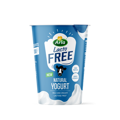
Lactose intolerance is the reduced ability to digest lactose – the natural sugar in milk and other dairy products.
If you are lactose intolerant, it means that your body produces too little of the enzyme lactase, which is required to digest lactose. Being lactose intolerant doesn’t mean being allergic to milk, it just means that you tolerate less lactose and therefore may experience gastrointestinal discomfort when you consume dairy products. Read more about lactose intolerance vs. milk allergy.
Over the course of your life, your body can start to produce less of the lactase enzyme, which means that you can develop lactose intolerance later in life.

Lactose intolerance is completely harmless
Lactose intolerance is harmless and in fact normal for most adults in the world. Most children tolerate lactose so intolerance before school age is very uncommon. The reason is that breast milk contains a much higher proportion of lactose than milk.
A different tolerance for different people
Without being experts on the matter, it seems that how much lactose one can tolerate and what reactions you see if you are lactose intolerant differ from person to person. If a lactose intolerant person eats too much lactose at once, the stomach can be bloated and churning, and diarrhoea may occur, but it’s always a good idea to contact your doctor if you experience any of these symptoms. If you're lactose intolerant, it's all about finding the right level - maybe one daily glass of milk or one portion of yogurt is what you can tolerate.
The four types of lactose intolerance
Before reading on, let’s just say this: we’re not scientists or the likes, we just really love great-tasting lactose-free dairy. So, if you need more in-depth information, please consult your doctor or dietician. From what we know from general research, also called googling, lactose intolerance is divided into four different types:
- Congenital lactose intolerance
- Primary lactose intolerance
- Secondary lactose intolerance
- Developmental lactose intolerance
Congenital lactose intolerance
Perhaps you know congenital lactose intolerance as genetic or hereditary lactose intolerance. It’s a very unusual form in which the baby already reacts to the milk sugar in breast milk. This form is caused by a genetic fault resulting in the baby not producing enough lactase. Both parents must carry the faulty gene for it to be passed on to the baby, so it’s a rare type of lactose intolerance. Again, if you want more in-depth information, please consult your doctor or dietician.
Primary lactose intolerance
Primary lactose intolerance is the most common form in which too little lactase enzyme is produced in the intestine. This means that not all lactose is broken down in the small intestine as it should be.
Like the congenital form, primary lactose intolerance is also caused by a genetic fault that is passed on. As opposed to the type above, primary lactose intolerance usually shows after the age of two, when the child doesn’t get breast milk or formula anymore. As the diet no longer consists primarily of milk and dairy, lactase production decreases. In many cases, the symptoms don’t show until adulthood.
Secondary lactose intolerance
Secondary lactose intolerance is also very common and is seen at all ages. It can occur in connection with medication, intestinal infection, or intestinal damage such as gluten intolerance. This form is often transient and involves a temporary decrease in the ability to break down lactose. Once the injury has healed, the gut's ability to break down lactose returns.
Secondary lactose intolerance can also develop without any triggering condition – usually later in life – when the production of lactase in the body naturally reduces.
Developmental lactose intolerance
Developmental lactose intolerance is sometimes seen in babies that are born prematurely if their small intestine isn’t fully developed when they’re born. Developmental lactose intolerance is usually temporary and improves as the baby grows older
Foods that contain lactose
Lactose is found in milk. Easy right? Unfortunately, it’s not that easy
If you want to live without lactose it’s probably no surprise that you should avoid products that contain lactose. But which products hold lactose, and which don’t? Let’s go through the basics – and remember to consult your doctor or dietician if you have any doubts or questions.
Lactose is found in milk. Easy right? Unfortunately, it’s not that easy, as this means that lactose is also found in products and food containing milk: other dairy products such as yogurt, cream, cheese, butter, and ice cream as well as bread, biscuits, mayonnaise, chocolate, etc. The list is quite long when you start writing it down, so we won’t do that here.
You can always check the ingredients list of any product to make sure that it doesn’t contain lactose.
Foods you can eat
If you suspect that you may be lactose intolerant, you can still enjoy some regular dairy products.
Many people with lactose intolerance can still eat yellow cheese because of the low level of lactose (less than 0.05 g of lactose per 100 grams of cheese). Most lactose intolerant people can also eat yogurt as the lactic acid bacteria ease the digestion of lactose.
Obviously, lactose free products are also an option. Arla LactoFREE is the taste of real dairy but without lactose – simply dairy goodness.













































